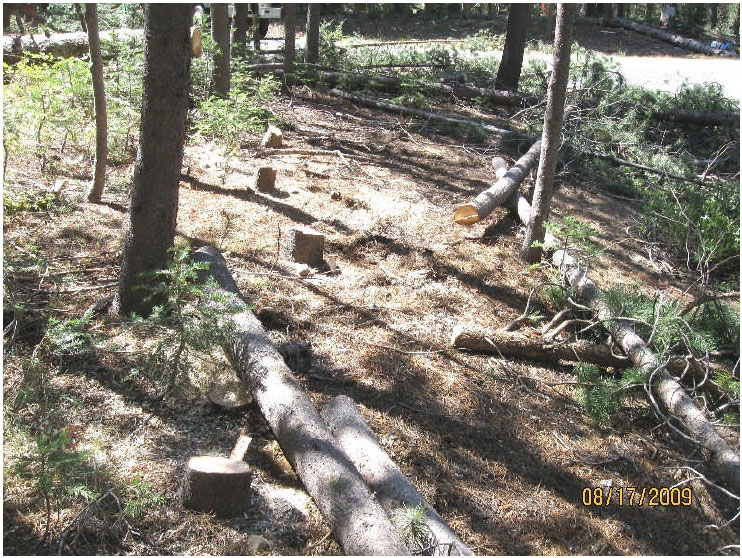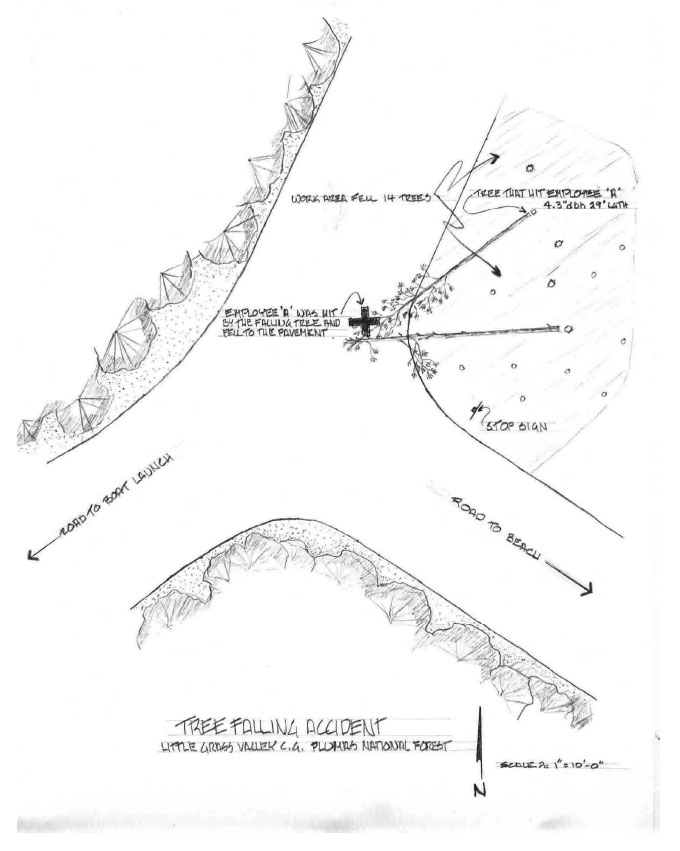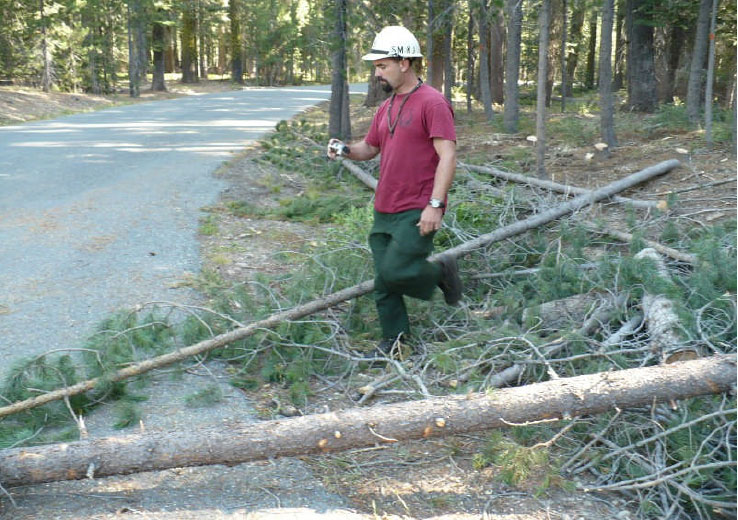- March 7-10, 2024
- April 11-14, 2024
- May 2-5, 2024
- May 30-June 2, 2024
- June 20-23, 2024
- July 11-14, 2024
- August 1-4, 2024
- August 22-25, 2024
Cost: $750 includes tuition, books, meals & lodging.
Freeman Reservoir tree felling fatality, 72-hour report & OSHA citation — June, 2009
Andrew Palmer Fatality, Dutch Creek Incident, — June, 2008
OSHA citations
|
Little Grass Valley Tree Felling Accident
Facilitated Learning Analysis
August 17, 2009
US Forest Service, Pacific Southwest Region, Plumas National Forest
Feather River Ranger District
ACCIDENT NARRATIVE
SETTING
The Little Grass Valley Recreation Area on the Plumas National Forest is a large
developed recreation site adjacent to a small reservoir. The recreation site features
several picnic areas, campgrounds, boat launching areas and group use areas. The
recreation area is within a mature stand of sierra mixed conifer, at about 5000’
elevation on gently rolling terrain in north central sierra mountains. A silvicultural
treatment was approved for this area to enhance forest health and visual aesthetics.
This treatment involved thinning, brushing by hand and with an excavator mounted
masticator. The slash was to be piled in certain areas and in other areas would be cut
up for firewood collectors or chipped and dispersed. Over one hundred acres within this
recreation area were to be treated by this thinning operation. The portions of the
recreation area undergoing treatment would need to be closed to the public for safety
reasons so this put some pressure on the Forest Service to complete the treatment
quickly.
Photograph 1: Treated (thinned) area

On August 10th, the field project manager implemented a complex but highly efficient
plan utilizing the masticator, the chipper and as many as six employees operating
chainsaws along with other employees piling debris, treating stumps, serving as road
guards, etc. All together over 20 Supervisor’s Office and Ranger District employees
would be directly involved in this tightly orchestrated project expected to take
approximately six weeks.
THE ACCIDENT
On August 17th, the first day of the second week of project implementation, most of the
employees involved in the project began the day at 0600 at the district office. The
employees were briefed on the project status, expectations for the week, and given a
safety briefing. After the briefing, most of the workers drove up to the recreation area
and began work. The weather that day was clear, winds calm and with temperatures
seasonal, but slightly warmer than normal for mid-August.
At this morning meeting, and in other conversations, it was made clear to the workers
that the project was taking longer than expected due to a variety of complications.
Many workers felt they were encouraged to increase the pace and tempo of the
operation. Safety and compliance with the mitigations listed in the Job Hazard
Analyses were continuously emphasized.
At various times throughout the morning employees arrived at the work site. One of the
specific sites needing to be treatedwas a small area about an eighth of an acre in size.
Two temporary (1039) employees paired up to complete the treatment of this site.
Both of these employees (hereinafter referred to as Employee A and Employee B)
worked under the engineering organization on the forest in the wage grade series.
These employees were referred to as: workers, laborers, road crewmembers and as
engineering techs. Employee B has worked on the same engineering labor crew for
three prior seasons doing a variety of work including working on road maintenance and
right-of-way clearing. The summer of 2009 was Employee A’s first season of
experience. This employee began work in April and had almost 4 full months of Forest
Service experience. As with Employee B, much of this experience was working in
brushing and clearing operations.
Employee A and B both donned their personal protective equipment and began cutting
the designated trees within the small area. Approximately 20 small trees had been
marked with paint to designate them as the trees that were to be cut down. Both
employees had the intention of cutting down all the marked trees and then going back
over the area to cut up the larger pieces for firewood collectors and pile the slash (limbs
and tops) for a subsequent chipping operation.
Together the employees had cut down approximately 14 trees in this area when
Employee A evidently decided to limb and buck1 a relatively large tree (7.5” diameter
breast high (dbh)) that after falling was blocking much of their access road. Employee
A walked from the base of that tree out to roughly the center of the access road limbing
the tree as s/he walked. Employee A then cut the top portion of that tree off and then
began bucking the main stem of the tree as s/he worked back to the base of the tree.
At about the time Employee A cut the top off of this tree, Employee A was
approximately 35 feet away from a tree Employee B was beginning to cut.
The tree Employee B began to cut at this time was 29 feet tall and 4.3 inches dbh.
Employee B made an undercut then a back cut intending to fall the tree towards the
road but believing Employee A was too far away to be in any danger. When the tree
began to fall, Employee B noticed that Employee A was now only about 25 feet away.
Employee B dropped her/his saw and tried to push the falling tree so that it would not
fall upon Employee A. The top of the falling tree however, whipped down on Employee
A’s hard hat causing the employee’s injury. The part of the tree that hit Employee A
was 1.5 inches in diameter and approximately 3 feet from the tip of the tree.
See Figure 1, photograph 2 and 3 below:
1 To “limb” and “buck” a tree refers to the action of cutting off all major tree limbs and then cutting the
main trunk in to smaller sections (bolts) for either firewood or for ease of carrying.
Figure 1: Artist’s sketch of the accident site:

Photograph 2: This picture shows of the top portion of the tree that hit Employee A
laying on top of the tree Employee A was bucking at the time of the accident:

Photograph 3: Picture showing the tree that Employee A was bucking in the foreground
and the tree that Employee B cut immediately to the right side of the individual.

ACCIDENT RESPONSE NARRATIVE
At approximately 10:10 on August 17, 2009 an employee from the Plumas National Forest
was struck on the hard hat s/he was wearing by a felling tree. This incident occurred while
the employee was involved in a thinning operation at the Little Grass Valley Recreation Area
on the Feather River Ranger District of the Plumas National Forest (NF). The employee was
struck by a small tree (29’ long, 4.3” dbh lodgepole pine), felled by another employee, while
s/he was bucking branches from another felled tree.
Another employee, who was also working on the same project, came to assist when s/he
heard loud voices, the stopping of chainsaw activity, and one of the sawyers running toward
the Forest Service truck. This employee also went to the Forest Service truck and tried to
contact the dispatch office on the radio. The employee was unable to contact dispatch on
this truck’s radio. After a few minutes of trying, s/he walked down to another truck, about
200 feet away, and got a hand held radio with which s/he was able to reach Plumas
Dispatch.
Plumas Dispatch received the call from the employee at 10:19 reporting the incident and
requesting medical support and evacuation. A Medivac helicopter (REACH 7) was
dispatched from Sutter Memorial Hospital in Yuba City and the Bi-County Ambulance # 109
also responded. At 10:24 a fire engine and crew from the Plumas NF responded. The La
Porte Volunteer Fire Department responded at 10:25 and a second Forest Service engine
also responded to the dispatch office’s request to assist an employee.
The La Porte Volunteer Fire Department Engine was the first to arrive on scene at 10:54
and began stabilizing the patient. The two Forest Service engines arrived at 11:10 and
assisted the La Porte crew VFD as needed.
Helicopter REACH 7, for reasons unknown, was observed circling over the Brownsville area
at 10:55. It circled Brownsville for a short time then proceeded to the incident area.
REACH 7 arrived shortly after 11:10. REACH 7’s pilot did not want to use the predesignated
parking lot to land in the parking areas near the accident site and instead set
down on the beach near the Red Feather Campground about 1 mile from the injured
employee. The employee was stabilized and placed on a backboard. The Bi-County
Ambulance arrived at 11:34 and the patient was loaded into the ambulance for transport to
the helicopter. At 11:46 REACH 7 was in route for a 25 minute flight to the hospital.
<<< continue
reading—Little Grass Valley Tree Felling Accident FLA lessons learned >>>
|